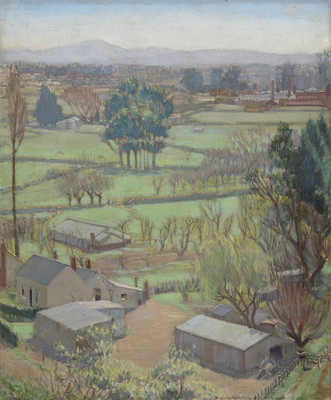B.
Across the plains by Viola Macmillan Brown Notariello
Collection
This article first appeared as 'Her own voice' in The Press on 23 November 2012.
Viola Macmillan Brown (1897-1981) was a leading light in Christchurch artistic circles of the 1920s and 1930s, but she left to marry the Italian opera singer Antonio Notariello (1892-1975) in England in 1936. Across the plains was a gift of their daughters in 2007. As well as bringing this artist to our attention, it is a pleasing, decorative record of an area now greatly changed; the semi-rural outskirts of early Christchurch, looking north from the lower eastern slopes of Cashmere towards a distant Mount Grey. It was painted not far from where she lived with her father, Professor John Macmillan Brown, a founding professor of Canterbury College (later University of Canterbury), who married the ground-breaking Helen Connon, second woman in the British Empire to receive a BA, first to receive an honours degree, and principal of Girls' High from 1882 to 1894. Viola was barely five when her mother tragically died. She and her elder sister Millicent (the poet James K. Baxter's mother) effectively were raised by a governess; their father's Cashmere home became an important cultural hub.
John Macmillan Brown intended that Viola would study at Oxford – Millicent had gone to Cambridge – but his high expectations inadvertently led to a different path. From around 1915 Viola studied at the Canterbury College School of Art and from 1919 at Julian Ashton's Sydney Art School. She exhibited with a group of Australian women artists in Sydney in 1921, but around 1922 travelled to Europe to study at the Slade and Heatherley art schools in London, before spending a year in Florence. Her Italian lessons continued in Christchurch; her future husband first visited New Zealand in 1921 and settled here in 1923, becoming a singing tutor to some 300 pupils before leaving for England at the end of 1926. (Viola's father did not view Signor Notariello as an ideal match; they were married at last after her father's death in 1935.)
In 1927, with a coterie of local artists including her friends Evelyn Polson (later Page) and close relative Ngaio Marsh, Viola was a founding member of The Group, formed in reaction to the stifling traditionalism of the Canterbury Society of Arts. A 1931 critic noted 'The lyrical tonal paintings of Miss Macmillan Brown draw one to quiet contemplation ...There is an aloofness, a feeling conveyed of some thread of melody coming from afar in her charming low-toned landscapes.' Viola Macmillan Brown showed with The Group until 1935, alongside newly-added company including Edith Collier, Francis Shurrock, R.N. Field, Rita Angus, Rata Lovell-Smith and Louise Henderson. As she followed her heart, Christchurch lost one of its more progressive artists. The gift of this painting is an exquisite reminder.
Ken Hall

Viola Macmillan Brown Notariello (1897–1981) Across the Plains c.1931 Collection of Christchurch Art Gallery Te Puna o Waiwhetū. Gift of Antonietta Baldacchino and Felicity Brichieri-Colombi, 2007.

